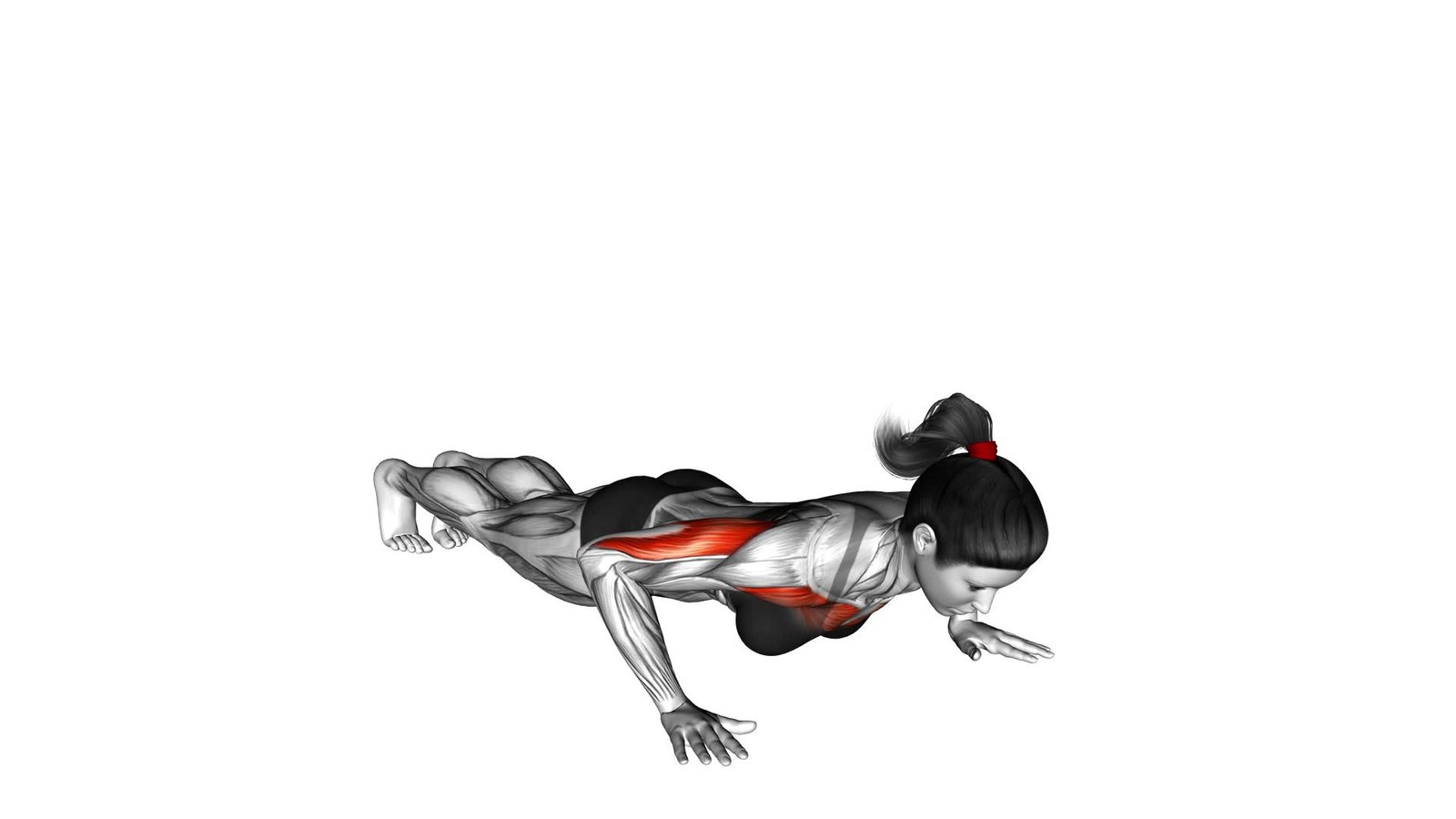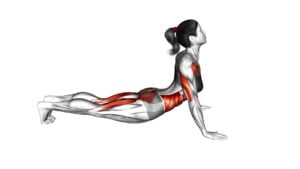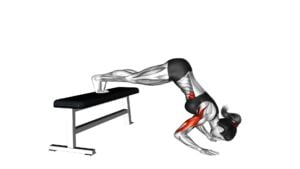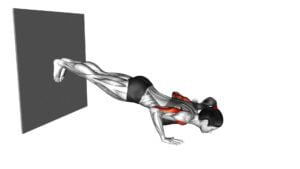Push-up (female) – Video Exercise Guide & Tips

Get ready to strengthen and tone your upper body with push-ups!
Watch This Exercise Video
In this video exercise guide, we'll show you proper form and technique for the female push-up. Whether you're a beginner looking for modifications or an advanced exerciser seeking variations, we've got you covered.
Avoid common mistakes and learn tips to increase your push-up strength and endurance.
Let's dive in and start empowering your fitness journey!
Key Takeaways
- Push-ups target multiple muscle groups simultaneously.
- Proper form and technique are important for maximizing the benefits of push-ups.
- Push-ups can be modified to suit different fitness levels and goals.
- Consistency, progression, and proper nutrition are key for improving push-up strength and endurance.
Benefits of Push-ups for Women
You can experience numerous benefits by incorporating push-ups into your workout routine as a woman. Push-ups offer a variety of variations specifically tailored for women, allowing you to target different muscle groups and achieve overall upper body strength. One such variation is the wide-grip push-up, which targets the chest muscles and helps to tone and strengthen the pectoral muscles. Another variation is the diamond push-up, where you place your hands close together in a diamond shape, targeting the triceps and improving arm strength. By incorporating these variations into your routine, you can effectively work your upper body muscles and achieve a sculpted and toned physique.
In addition to improving upper body strength, push-ups provide a range of benefits for women. They engage multiple muscle groups simultaneously, including the chest, shoulders, triceps, and core muscles. This not only helps to build overall strength but also improves muscular endurance. Push-ups also promote stability and balance, as they require you to engage your core and maintain a straight body position throughout the exercise.
Proper Push-up Form and Technique
To perform a proper push-up, ensure that your body forms a straight line from your head to your heels. This is the foundation of a correct push-up form and technique. By maintaining this alignment, you engage your core muscles and work the entire upper body effectively.
Push-ups offer numerous benefits for both men and women. They strengthen the chest, shoulders, triceps, and core muscles. Push-ups also improve posture, enhance upper body stability, and increase overall strength. Additionally, push-ups can be modified to suit different fitness levels and goals.
To begin a push-up, start by placing your hands slightly wider than shoulder-width apart on the floor. Lower your body until your chest is close to the ground while keeping your elbows tucked in. Push back up to the starting position, ensuring that your body remains in a straight line throughout the movement.
There are several push-up variations you can try to target different muscle groups and add variety to your workout routine. Some popular variations include wide-grip push-ups, diamond push-ups, incline push-ups, and decline push-ups. Each variation targets specific muscles and challenges your body in different ways.
Beginner Modifications for Push-ups
Now let's talk about some beginner modifications for push-ups. If you're just starting out, you might find it challenging to perform a full push-up. That's where these modifications come in handy.
We'll cover the knee push-up modification, the incline push-up modification, and the assisted push-up modification to help you build strength and progress towards a full push-up.
Knee Push-Up Modification
Start by positioning yourself on your knees for a modified push-up. This variation is perfect for beginners who may not have the strength to perform a full push-up yet.
Here are four modified push-up variations that you can try:
- Knee Push-Up: Place your hands slightly wider than shoulder-width apart on the ground. Lower your chest towards the floor by bending your elbows, keeping your back straight. Push back up to the starting position.
- Incline Push-Up: Find an elevated surface like a bench or step. Place your hands on the surface and walk your feet back, creating an incline. Lower your chest towards the surface and push back up.
- Wall Push-Up: Stand facing a wall with your arms extended, shoulder-width apart. Lean towards the wall, bending your elbows and bringing your chest towards the wall. Push back to the starting position.
- Assisted Push-Up: Use a resistance band or a TRX band to provide assistance. Loop the band around your back or hold onto the TRX handles. Perform the push-up with the assistance of the band or TRX.
These modified push-up variations and alternatives will help you gradually build your strength and progress to the full push-up. Remember to maintain proper form and listen to your body to prevent any injuries.
Incline Push-Up Modification
You can modify the push-up exercise by performing an incline push-up.
Incline push-ups are a great modification for beginners as they help build strength and improve form.
To perform an incline push-up, find a stable elevated surface like a bench or step. Place your hands on the elevated surface slightly wider than shoulder-width apart. Your body should be in a straight line from head to toe.
Lower your chest towards the surface by bending your elbows, keeping your core engaged. Push back up to the starting position.
As you get stronger, you can gradually decrease the height of the elevated surface to increase the difficulty of the exercise.
Incline push-ups are beneficial for women as they target the chest, shoulders, and triceps while reducing strain on the wrists and lower back.
Assisted Push-Up Modification
To modify the push-up exercise and make it more accessible for beginners, you can try the assisted push-up modification. This variation provides support to help build strength and gradually progress towards performing a full push-up. Here are four alternative push-up variations that can assist you in mastering this exercise:
- Knee Push-Ups: Start on all fours and lower your upper body towards the ground, keeping your knees on the floor. This modification reduces the amount of body weight you're lifting, making it easier to perform.
- Wall Push-Ups: Stand facing a wall and place your hands on the wall at shoulder height. Slowly lower your body towards the wall, then push back up. This modification allows you to control the amount of resistance.
- Incline Push-Ups: Use an elevated surface, such as a bench or step, to perform push-ups. Place your hands on the elevated surface and lower your body towards it, then push back up. This modification decreases the amount of weight you're lifting.
- Resistance Band Push-Ups: Loop a resistance band around your back and hold the ends in your hands. Assume the push-up position, with the band providing assistance as you lower your body towards the ground. This modification adds resistance and aids in building strength.
By incorporating these assisted push-up modifications into your routine, you can gradually progress towards performing full push-ups.
Now, let's explore some advanced variations for push-ups.
[Transition sentence: Now that you have learned about the assisted push-up modifications, let's move on to the advanced variations for push-ups.]
Advanced Variations for Push-ups
Master the challenging variations of push-ups to take your upper body strength to the next level. Push-up progressions are advanced modifications that can help you build strength, increase muscle endurance, and improve overall fitness. These variations target different muscle groups and add intensity to your workout.
One advanced variation is the decline push-up. Place your feet on an elevated surface, such as a bench or step, while keeping your hands on the ground. This position increases the workload on your shoulders, chest, and triceps.
Another challenging variation is the diamond push-up. Start in a traditional push-up position, but place your hands close together, forming a diamond shape with your thumbs and index fingers. This variation targets your triceps and chest muscles more intensely.
If you're looking to engage your core and shoulder stabilizers, try the pike push-up. Begin in a downward dog position with your hips raised and your body forming an inverted V shape. Lower your head towards the ground by bending your elbows, and then push back up. This variation primarily targets your shoulders and upper back.
Remember to maintain proper form and listen to your body. Start with the variation that challenges you the most, and gradually progress as your strength improves. Incorporating these advanced variations into your push-up routine will help you achieve greater upper body strength and overall fitness.
Common Mistakes to Avoid During Push-Ups
When performing push-ups, it's important to avoid common mistakes that can hinder your progress and potentially lead to injury.
One common mistake is incorrect hand positioning, which can put unnecessary strain on your wrists and shoulders.
Additionally, sagging or arching your back can compromise the effectiveness of the exercise and increase the risk of lower back pain.
Lastly, failing to engage your core muscles can result in poor form and limit the benefits of the push-up.
Incorrect Hand Positioning
Avoid the common mistake of placing your hands incorrectly during push-ups. Proper hand placement is crucial for maintaining proper form and preventing injury. Here are some tips to ensure correct hand positioning:
- Align your hands directly under your shoulders, slightly wider than shoulder-width apart. This will provide stability and support throughout the exercise.
- Spread your fingers wide and press your palms firmly into the ground. This will engage your forearm muscles and help distribute the weight evenly.
- Keep your fingers pointing forward or slightly outward. Avoid angling your hands inwards, as this can strain your wrists.
- Maintain a straight line from your wrists to your shoulders. Avoid letting your shoulders hunch up or sag down, as this can lead to shoulder pain and instability.
Sagging or Arching Back
To prevent sagging or arching your back during push-ups, ensure proper alignment of your body. Maintaining a straight and neutral spine is crucial to avoid straining your lower back and experiencing back pain.
Start by positioning your hands directly under your shoulders and your feet hip-width apart. Engage your core muscles to keep your spine in a stable position throughout the exercise.
As you lower your body towards the ground, focus on keeping your back straight and avoiding any sagging or arching. This will distribute the workload evenly and prevent unnecessary strain on your back muscles.
Lack of Core Engagement
You need to engage your core muscles properly to avoid making the common mistake of lacking core engagement during push-ups. Failing to engage your core can lead to a lack of stability and strength, compromising your form and limiting the effectiveness of the exercise.
Here are four key tips to ensure proper core engagement during push-ups:
- Start by engaging your deep core muscles, such as the transverse abdominis, by drawing your belly button towards your spine.
- Maintain a neutral spine throughout the exercise, avoiding any excessive arching or sagging.
- Imagine a straight line from your head to your heels, keeping your body in a plank position.
- Squeeze your glutes and engage your pelvic floor muscles to further stabilize your core.
Tips for Increasing Push-up Strength and Endurance
Developing proper form and technique is essential for enhancing your push-up strength and endurance. To increase your push-up reps and improve your overall performance, it's important to follow a progressive training program.
One effective strategy is to start with modified push-ups, such as doing them on your knees or against a wall, and gradually progress to full push-ups. This allows you to build strength and gradually increase the number of reps you can do.
Additionally, incorporating push-up progressions into your routine can help challenge your muscles and stimulate further gains. Some effective progressions include incline push-ups, where your hands are elevated on a bench or step, and decline push-ups, where your feet are elevated. These variations increase the difficulty and engage different muscle groups, helping you build strength and endurance.
Consistency is key when it comes to increasing push-up strength and endurance. Aim to perform push-ups at least three times a week, gradually increasing the number of sets and reps over time. It's also important to listen to your body and allow for adequate rest and recovery. Proper nutrition and hydration are crucial for supporting muscle growth and improving overall performance.
Frequently Asked Questions
Can Push-Ups Help Me Lose Weight?
Yes, push-ups can help you lose weight. They're a great exercise that targets multiple muscle groups and burns calories. By incorporating different push-up variations and maintaining proper form, you can increase the intensity and effectiveness of the exercise.
Push-ups engage your chest, shoulders, triceps, and core muscles, which helps to build strength and tone your body. Additionally, they can help increase your metabolism, leading to weight loss when combined with a balanced diet and regular exercise routine.
How Many Push-Ups Should I Do in a Day?
To determine how many push-ups you should do in a day, it's important to consider workout variations and proper push-up form. The number of push-ups you do depends on your fitness level and goals.
Start with a number that challenges you but is still manageable, and gradually increase it over time. Remember to maintain proper form throughout the exercise to avoid injury and maximize results.
Consult with a fitness professional for personalized recommendations.
Are Push-Ups Suitable for Women With Weak Wrists?
Push-ups can be a great exercise for women, but if you have weak wrists, it's important to take some precautions. Strengthening your wrists with specific exercises before attempting push-ups can help prevent injury.
Additionally, there are modifications you can make to make push-ups more wrist-friendly. For example, doing push-ups on your fists or using push-up handles can help take some pressure off your wrists.
It's always a good idea to consult with a fitness professional to ensure you're doing exercises safely and effectively.
Can Push-Ups Help in Toning My Chest Muscles?
Push-ups are a great exercise for toning your chest muscles. They target your pectoral muscles, helping to strengthen and define them.
There are many push-up variations that you can try to target different areas of your chest and make the exercise more challenging. These variations include wide grip push-ups, diamond push-ups, and decline push-ups.
Incorporating these variations into your routine will help you achieve your desired chest-toning results.
Are Push-Ups Beneficial for Pregnant Women?
Push-ups can be a great exercise for toning your chest muscles. However, when it comes to pregnant women, safety precautions should be taken. During pregnancy, it's important to listen to your body and avoid exercises that put too much pressure on your abdomen.
Push-ups mightn't be the best option for you. But there are alternative exercises that can still help you stay active and maintain muscle tone. Consult with your doctor or a prenatal fitness specialist for personalized recommendations.
Conclusion
In conclusion, push-ups are a beneficial exercise for women as they help strengthen the upper body, core, and improve overall fitness.
By maintaining proper form and technique, women can maximize the effectiveness of push-ups and avoid common mistakes.
Beginners can start with modifications and gradually progress to advanced variations to challenge themselves.
To increase push-up strength and endurance, consistency and gradual progression are key.
Incorporating push-ups into a regular workout routine can lead to improved strength and toning for women.

Author
Years ago, the spark of my life’s passion ignited in my mind the moment I stepped into the local gym for the first time. The inaugural bead of perspiration, the initial endeavor, the very first surge of endorphins, and a sense of pride that washed over me post-workout marked the beginning of my deep-seated interest in strength sports, fitness, and sports nutrition. This very curiosity blossomed rapidly into a profound fascination, propelling me to earn a Master’s degree in Physical Education from the Academy of Physical Education in Krakow, followed by a Sports Manager diploma from the Jagiellonian University. My journey of growth led me to gain more specialized qualifications, such as being a certified personal trainer with a focus on sports dietetics, a lifeguard, and an instructor for wellness and corrective gymnastics. Theoretical knowledge paired seamlessly with practical experience, reinforcing my belief that the transformation of individuals under my guidance was also a reflection of my personal growth. This belief holds true even today. Each day, I strive to push the boundaries and explore new realms. These realms gently elevate me to greater heights. The unique combination of passion for my field and the continuous quest for growth fuels my drive to break new ground.







